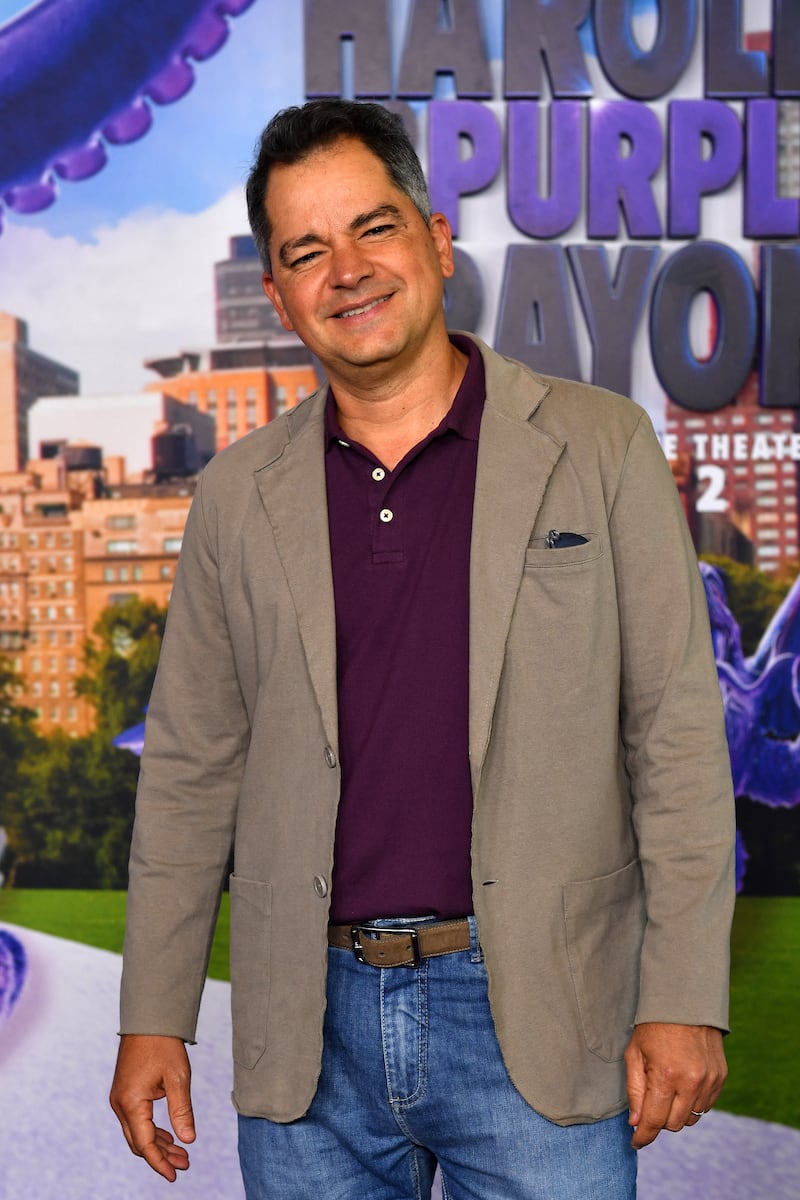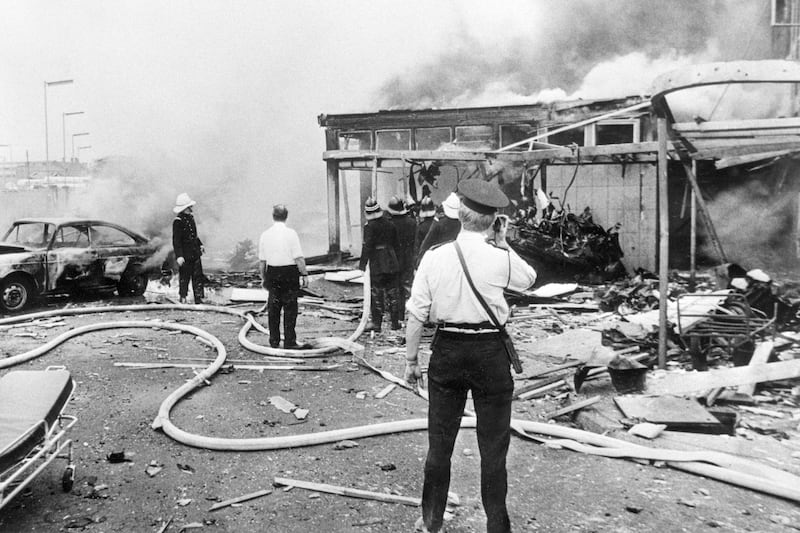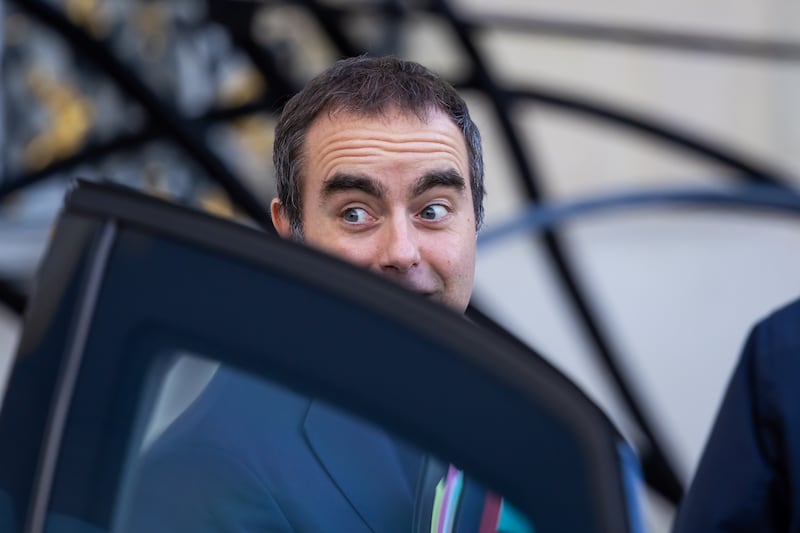Crockett Johnson’s 1955 children’s book Harold and the Purple Crayon, now a film from Columbia Pictures, does not have quite the resonance on this side of the Atlantic as it does in its home United States, but at least one reverberation touched a generation of pop-culture junkies throughout the world. In Neal Karlen’s book This Thing Called Life: Prince’s Odyssey, On and Off the Record, Mattie Shaw, Prince’s mother, suggests the late Minnesotan got his love of purple from Johnson’s durable children’s book. Carlos Saldanha, director of the new film, is hearing this for the first time.
“I didn’t know that,” he says. “I always question: why purple? But that became the colour and then I embraced it. Ha ha!”
Saldanha, a Brazilian animator best known for the staggeringly popular Ice Age series, has made an agreeable family entertainment of Johnson’s story. Zachary Levi plays the eponymous Harold, a childlike man with a crayon that can cause drawings to come to life. When Harold sketches a bike it swells out to something you can actually ride. Zooey Deschanel is a responsible adult dealing with this oddball in contemporary Rhode Island. Combining live-action and animation, the flick is perfectly positioned for the second half of the school holidays.
“I grew up in Brazil, so the book was not that familiar,” Saldanha says. “But my kids were born in the US. I read the books with them in the US as many other parents did. And I didn’t know that the book was that old, because it felt so fresh. It felt so unique. The simplicity of the message will always capture me. It’s the kind of book you read and have to talk about, even though the story is simple.”
READ MORE
Johnson’s little pal Harold allied himself ... with the beboppers and other jazz masters
It is some measure of the book’s place in American society that so many distinguished creatives have sought to get a feature version on the big screen. More than 30 years ago, Maurice Sendak, author of Where the Wild Things Are and a disciple of Crockett Johnson, acquired the rights and brought in Henry Selick, director of The Nightmare before Christmas, to work on an adaptation. Spike Jonze then toiled on it with David O Russell before a plug was pulled. As long ago as 2010, Columbia came on board, initially with Steven Spielberg’s Amblin Entertainment. There was a TV series for HBO and a short in 1959. The book has worked its spell on three or four generations.
What is going on here? In a 2022 essay for Literary Hub, Ross Ellenhorn identifies the date of publication as a pivotal point in US society. Nineteen fifty-five was a time of complacency in the white suburbs and cultural entrenchment by corporate America. The baby-boom generation, swollen with postwar wealth, needed stuff to put in their fridge and bigger stuff to put in their garage. “It was also the year that Disneyland, a terrain of manufactured imagination and an automated, assembly-line approach to our most interior experiences, opened its gates,” Ellenhorn notes.
Lest fans of Crockett Johnson bristle, we should clarify that the essay positions his book within the cultural resistance. Contemporaneous audiences had to squint hard to discern that fightback in the mainstream culture. You saw it in the hollow establishment delusions undermined in gorgeous Douglas Sirk films such as Magnificent Obsession and Leave Her to Heaven. On TV you could maybe see it in the cynicism of Phil Silver’s scheming Sergeant Bilko (another 1955 debut). But the real alternative was out there in the music clubs, the comedy bars and the independent publishers. “Johnson’s little pal Harold allied himself ... with the beboppers and other jazz masters,” Ellenhorn writes. “With the Beats, the folk revivalists, the modern dancers and the rock-and-rollers; the critical theorists, the existentialists, the Mattachinists and the absurdists.”
A stretch? Well, no. The hero of Harold and The Purple Crayon – which spawned a volley of equally successful sequels – is empowered by creativity and individual thinking. There is a sense of a boy who, rather than accepting the world as defined, is compelled to fashion his own environment to his own standard. A glance at Johnson’s biography confirms he would be unlikely to object to positioning alongside the beatnik poets and the postbebop saxophonists. He was more Mingus than Mantovani. He was a communist and an experimentalist. In later years, Johnson devoted himself to paintings, still highly collectible, inspired by mathematical equations and theorems. Not for nothing is Philip Nel’s dual biography of the creator and his wife, also a children’s author, entitled Crockett Johnson and Ruth Krauss: How an Unlikely Couple Found Love, Dodged the FBI, and Transformed Children’s Literature.

He was born, six years into the 20th century, as David Johnson Leisk in New York City to a German mother and a father raised in the far northern Shetland Islands. He later claimed he adopted the penname Crockett Johnson as “Leisk” was too hard to pronounce. The young artist studied at New York University before embarking on an early career as art editor for various McGraw-Hill trade publications. He swivelled, like many of his politically minded contemporaries, towards communism during the Great Depression of the 1930s and ended up on the staff of New Masses, a Marxist magazine that also published William Carlos Williams, John Dos Passos, Dorothy Parker and Ernest Hemingway.
Johnson’s cartoons of that era combine radical edge with a degree of self-satire. “Harriet here is practically an authority on communists. She writes pieces about them in the New Yorker,” a society lady opines pompously.
One can therefore appreciate how Ellenhorn’s argument about placing Harold with the radicals stands up. His creator travelled an arc familiar to dozens of now celebrated American writers, actors and directors – more than a few of whom fell foul of the McCarthyite witch hunts. In 1942, he achieved proper fame with his syndicated comic strip Barnaby, the story of an imaginative kid and his disreputable fairy godfather. “Barnaby and his friends and oppressors are the most important additions to American Arts and Letters in Lord knows how many years,” Dorothy Parker, never easy to please, raved. Harold and the Purple Crayon cemented his fame in that barbecue-and-Chevrolet year of 1955.
Back in those days, bringing up the communist connections of the source material for a studio film would constitute a potentially ruinous accusation. One couldn’t honestly argue that today. But it is, nonetheless, worth remarking that Columbia Pictures, now an organ of Sony, is happily taking us into the late summer with an adaptation of an author who stayed with the cause throughout the 1930s. I wonder what Saldanha makes of that side of Johnson’s life. Were the political undercurrents a consideration when adapting the source?
“I never went that route,” he says. “I never dug deeper into that sentiment. Back in the times, the context was completely different than it is now.”
Crockett Johnson died in 1975 at the age of 68. The name is little known outside the US, but within that country he stands as one among a legion of pioneers – many, like him, second-generation immigrants – who kept a radical creative spirit alive during the constricting postwar years. He didn’t exactly spawn a revolution. But, as we have learned, he helped spawn Prince and the Revolution.
Harold and the Purple Crayon is in cinemas from Friday, August 2nd





















